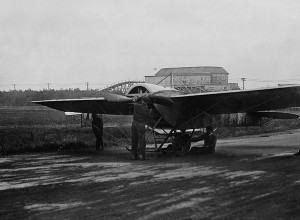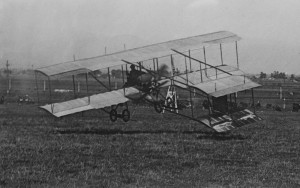Published on April 9, 2013
One hundred years ago in aviation history, on this date, British aviators were reading about the latest prize offerings from the Daily Mail, a newspaper in London that had been sponsoring the advancement of aviation since its first days. Widely distributed, the newspaper had deep pockets and, in exchange for sponsoring the prizes — which were often quite rich — it received excellent publicity and increases to its own sales and subscribers. Indeed, one can only wonder what early aviation might have been like without the incentives of the Daily Mail prizes to spur on the young and old alike to press the limits of flight.
Just how many such prizes were there? Quite a few, it turns out. And the two new prizes offered a century ago were serious challenges; in fact, one challenged the entire world to make the first flight across the Atlantic Ocean — and the year was 1913!

The Two New Daily Mail Prize Offers
The Royal Aero Club published the latest Daily Mail Prizes as follows:
ONCE more the proprietors of the Daily Mail have come forward and offered two generous prizes with the object of stimulating progress in the development of aviation, with which we deal elsewhere editorially.
The first prize is the sum of £5,000 to the first person who shall pilot a waterplane of entirely British invention and construction round England, Scotland, and Wales — and, so far as Ireland is concerned, within one mile of Kingstown Harbour — in seventy-two continuous hours, starting and finishing at a point to be agreed upon near the mouth of the Thames. The full regulations which will be drawn up with the assistance of the Royal Aero Club have not yet been decided upon, but it will be specified that certain parts of the machine shall be marked and that the machine must not descend on land at any point, although it may, of course, stop in harbours for the replenishment of its fuel supplies, &c.
The second prize is £10,000 to the first person who crosses the Atlantic from any point in the United States, Canada, or Newfoundland to any point in Great Britain or Ireland in seventy-two continuous hours. The flight may lie made, of course, either way across the Atlantic. This prize is open to pilots of any nationality, and machines of foreign or British construction.
Immediately, the Daily Mail received its first notifications from pilots intending to compete for the two new prizes — and these were reported as follows:
The Daily Mail announces that the first entries for both prizes are those of Messrs. Blériot, Ltd., and Col. Cody, while Mr. Gordon England and Herr Rumpler have also entered for the Atlantic prize, and Mr. J. Radley and Mr. G. L. Temple for the Round Britain prize.

Past Prizes
In the same announcement, the writers found it fitting to list the previously awarded Daily Mail Prizes, which serve as an excellent historic record of some of the greatest achievements in aviation history — at least until April 9, 1913, that is:
IN this connection the following summary of the prizes offered by the Daily Mail is not without interest:
- £10,000 for flight by aeroplane from London to Manchester in twenty-four hours with not more than two stoppages en route. Offered November 17th, 1906. Won by M. Paulhan on April 28th, 1910, with one stop en route at Lichfield. 193 miles covered in 242 minutes.
- £1,000 for flight across the channel between England and France, to be accomplished in daylight without touching the sea. Offered on October 5th, 1908. Won by M. Blériot, July 25th, 1909, in 46 minutes of flight.
- £1,000 for first circular flight of one mile in an aeroplane by a British subject in the British Isles on an all-British built machine. Won b y Mr. J. T. C. Moure-Brabazon in a Short aeroplane on October 30th, 1909, in 2 mins., 36 secs.
- £10,000 for circuit of Britain covering a distance of 1,000 miles in one day with eleven compulsory stops at fixed controls. Offered on May 22nd, 1910. Won by M. Beaumont on July 26th, 1911, in 22 hrs. 28 mins., at 45 miles an hour, defeating M. Védrines.
- £1,000 for greatest aggregate cross-country flight in the year ending August 15th, 1910. Won by M. Paulhan with 855 miles, defeating Mr. Grahame-White with 842 miles.
- £150, £75, and £25 for aeroplane models awarded after exhibition at the Agricultural Hall, April, 1907.
- £100 for half-mile flight (quarter-mile out and return), won by M. Henry Farman, January 14th, 1908.
- £100 cup for second cross-Channel flight. Won by Count Jacques de Lesseps, May 21st, 1910.
- £50 cup to John B. Moisant for flight from Paris to London, and smaller cup to his mechanic and passenger, Fileux. Won September 6th, 1910.
- £250 and gold cup for flight of 81 miles round London. Won by Mr. T. O. M. Sopwith on June 8th, 1912, in 90 minutes.

Looking Back and Looking Ahead
The list above constitutes a virtual “who’s who” of early aviation’s greatest flyers. Many other names are not on the list, but that wasn’t for a lack of trying. Even if some names on the list may be less known, the men (no women on the list at that point!) were nonetheless widely respected in that time. Looking back, all of aviation owes the Daily Mail a debt of gratitude for offering so many prizes and issuing those key challenges that set in motion more rapid advancements in all aspects, whether in aircraft design, piloting or even model building!
Today, a new generation of prize offerings have emerged, patterned on the famous Daily Mail challenges of 100 years ago. Once again, these prizes are offered to foster technological advances, though this time the challenge is to go into space and to the Moon. While it may have taken NASA just a bit less than a decade to put a man on the Moon the first time, it is likely that within about the same time private entrepreneurs and scientists will return to once again plant the flag.
Just how far will it go? We can only wonder if 50 years hence someone will offer a prize of $10 million for the first spacecraft to land on the surface of Pluto and beam back pictures….
Today’s Aviation Trivia Question
What other newspapers offered prizes in those early years of aviation history?
